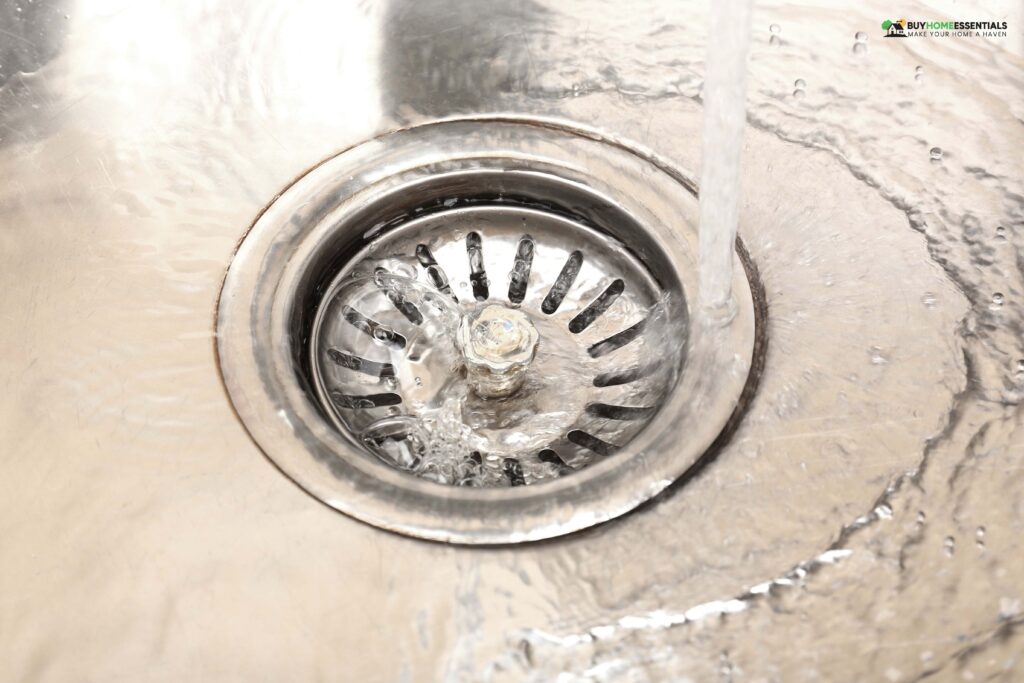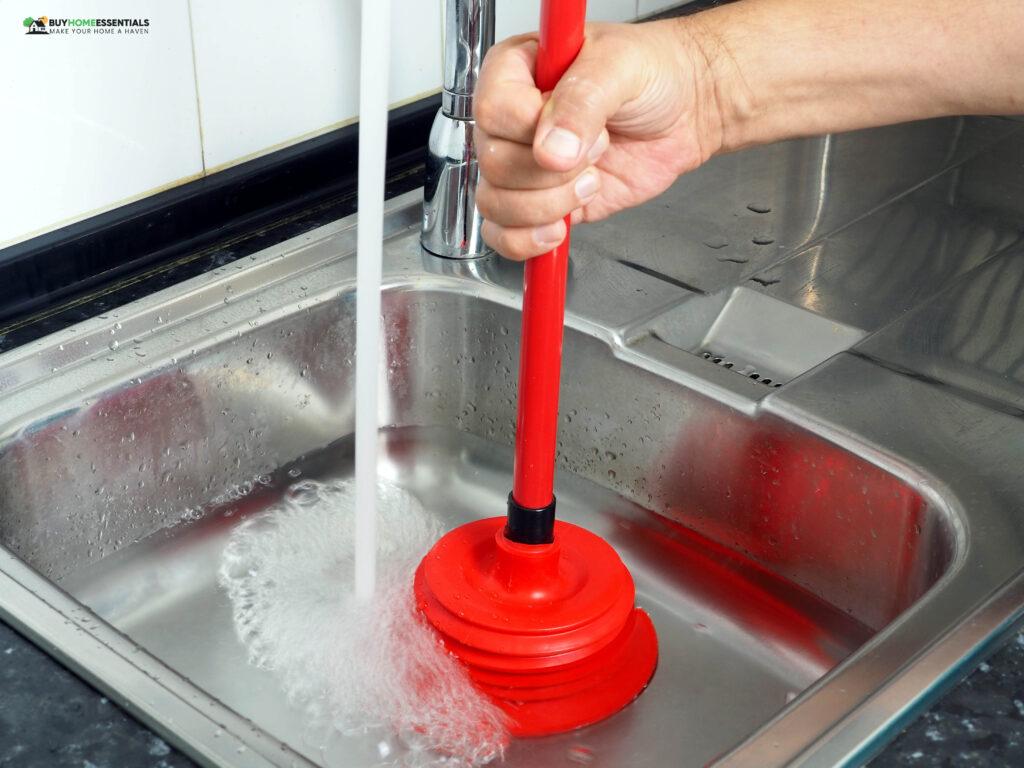Keeping your kitchen sink drain clean is essential for a functional and hygienic kitchen. Eventually, kitchen drains can accumulate debris, causing unpleasant odors and inefficient drainage. Hence, learning how to clean kitchen sink drain is a valuable skill that can save you from plumbing headaches and expenses.
Regular maintenance keeps the sink running smoothly and prevents costly repairs down the road. This guide shows you how to clean kitchen sink drains and keep your kitchen sink functional and fresh. We’ll equip you with the knowledge to maintain clean drains and promote a healthy kitchen. Let’s dive into drain maintenance and get rid of those clogs!
Common Causes of Kitchen Sink Drain Clogs

Having a well-functioning kitchen drain is crucial for smooth kitchen operations. Nevertheless, various factors can cause clogs and hinder its efficiency. If you understand these common clog causes, you can prevent future clogs.
Food Particles and Debris Accumulation
Food particles and other debris are a big reason for kitchen drain clogs. Food, grease, and particles can get in the sink when you wash dishes or prepare meals. Over time, these build up in the drain, causing a blockage. It’s essential to be mindful of what goes down the drain and take steps to minimize food waste.
Grease and Fat Build-Up
Many dishes use cooking oils, fats, and grease, but when disposed of improperly, they can cause problems. These substances can solidify and stick to the walls of drains and pipes, slowly building up and restricting water flow. Eventually, this build-up can cause stubborn clogs that can’t be fixed easily.
Soap Scum and Mineral Deposits
It’s common for soap residues to solidify in drains in hard water areas, which contributes to clogs. Furthermore, minerals in hard water can build up over time, causing deposits in drain pipes that block water flow.
It is essential to clean your drain regularly and prevent soap scum and mineral deposits from forming.
By understanding these causes of sink drain clogs, you can use proactive measures to maintain your sink’s drainage system.
What You Need to Clean Kitchen Sink Drain
You must have the right tools and equipment to clean a drain in your kitchen sink. The following items will help you clear clogs and keep your drain clean:
- Plunger
- Drain Snake
- Baking Soda and Vinegar
- Hot Water
- Pipe Brush
How to Clean Kitchen Sink Drain
The following instructions will demonstrate how to clean drain in kitchen sink.
Preparing to Clean the Drain
Prepare the area and gather the necessary tools before cleaning the kitchen sink’s drain. Cleaning is easier and more effective with proper preparation. Here are the steps to prepare for cleaning the drain:
Clear the Sink Area and Remove Visible Debris
Remove dishes, utensils, or other items from the sink and surrounding area. Keeping the sink area clear allows you to access the drain without obstruction and ensures safety.
Remove the Sink Stopper or Strainer
If your sink has a stopper or filter, remove it to access the drain directly. This step is crucial in most drain cleaning methods, as it lets you get into the drain and use the tools.
By clearing the sink area and removing the sink stopper or filter, you set the stage for successful drain cleaning.
How to Clean Kitchen Drain Sinks: Basic Methods
Basic drain cleaning methods often fix mildly clogged drains or perform routine maintenance. These methods use simple tools and household items to unclog minor clogs. Here are two commonly used basic drain cleaning methods:
1. Using a Plunger

Plungers are versatile and practical tools for removing minor clogs and improving drainage. The following steps will help you clear a clogged drain with a plunger:
- Place the plunger over the drain opening, ensuring a tight seal. Plungers should have a rubber cup that covers the drain completely.
- Push the plunger down firmly, then pull up quickly to create pressure and suction. Repeat this motion several times to dislodge the clog.
- After plunging, run water to check if the clog is cleared. If not, repeat the process.
2. Using Boiling Water
When it comes to minor clogs, boiling water is often an effective solution. Follow these steps to use boiling water for basic drain cleaning:
- Heat a pot of water until it reaches a rolling boil.
- Carefully pour the boiling water directly into the drain. Pour steadily and in stages so the hot water can dissolve the clog.
- Let the hot water work for a few minutes, then run regular tap water to see if the clog is gone.
These basic drain cleaning methods can be used for minor clogs and regular maintenance.
How to Clean Kitchen Sink Drain: Intermediate Methods
Advanced drain cleaning methods suit more challenging clogs that basic methods can’t handle. Using these methods, you can remove stubborn clogs using everyday household items. Here are two effective ways to clean intermediate drains:
1. Baking Soda and Vinegar
Baking soda and vinegar create a foaming reaction, which helps break down clogs and clear drains. Follow these steps to use this method:
- Remove as much standing water as you can from the sink using a bucket or towel.
- Pour about 1/2 cup of baking soda down the drain.
- Add 1/2 cup of vinegar to the baking soda. Immediately cover the drain to contain the fizzing action.
- Wait 30-60 minutes for the mixture to work. After that, flush the drain with hot water to remove the clog.
2. Using a Drain Snake
You can reach and unclog more stubborn clogs using a drain snake or plumbing auger. Here’s how to use a drain snake:
- Push the drain snake into the drain until you feel resistance, indicating the clog.
- Push the snake further into the drain by rotating the handle clockwise. It helps break up and remove the clog.
- Once the snake is withdrawn, pull out any dislodged debris or clogs that have formed.
- Flush the drain with hot water to ensure the clog is completely removed.
You can use these intermediate drain cleaning methods for moderately stubborn clogs.
How to Clean Kitchen Sink Drain: Advanced Methods
Advanced drain cleaning methods are necessary when drain clogs are persistent or severe. These methods might involve stronger solutions or professional help. Here are two ways to clean your drains:
1. Commercial Drain Cleaners
Using commercial drain cleaners can break down stubborn clogs. However, you should follow the manufacturer’s instructions. How to use a commercial drain cleaner:
- Follow the instructions provided on the packaging of the commercial drain cleaner carefully.
- Wear appropriate protective gear like gloves and safety goggles.
- Pour the recommended amount of the drain cleaner directly into the drain.
- Allow the cleaner to work for the specified duration. Afterward, flush the drain with plenty of water.
2. Calling a Professional

Unless you’re comfortable handling advanced drain cleaning techniques, it’s best to call a pro. Your plumber can remove persistent clogs and ensure the overall health of your plumbing system.
The plumber uses various methods to remove severe clogs, including hydro-jetting and specialized drain augers. In addition, they can identify underlying issues causing the clogs.
How to Clean Kitchen Sink Drain with Garbage Disposal
It takes a slightly different approach to clean a garbage disposal in the kitchen sink.
Equipment Needed
- Baking Soda
- Vinegar
- Ice Cubes
- Rock Salt
- Citrus Peels (optional for pleasant scent)
Here’s a step-by-step guide on how to clean a kitchen sink drain with a garbage disposal:
- Turn off the circuit breaker for the garbage disposal unit for safety reasons.
- Access the drain by lifting the rubber flaps inside the garbage disposal.
- Scrub the rubber flaps with an old toothbrush or scrub brush to remove any build-up or grime.
- Pour about 1/2 cup of baking soda into the garbage disposal.
- Follow it with a mixture of 1 cup of vinegar and a few drops of dish soap.
- Let the mixture fizz and work for 10-15 minutes to break down any residues.
- Drop a few ice cubes and a handful of rock salt into the disposal.
- Turn on the disposal and let the ice and salt help dislodge any build-up from the grinding components.
- Let the cold water run for a minute to flush away the loosened debris.
- Drop a few citrus peels (e.g., from lemons or oranges) into the disposal for a fresh scent.
- Grind the peels in the disposal to impart a pleasant aroma.
- Clean the disposal and drain thoroughly with cold water for a minute.
- Once a month, do this cleaning routine to keep your garbage disposal clean.
Related: How to Unclog a Kitchen Sink
The Takeaway
Cleaning your kitchen sink drain is essential to keep it running smoothly. You can prevent clogs, odors, and costly repairs by regularly using the cleaning methods in this guide. You can resolve clogs by plunging, using commercial cleaners, or seeking professional help.
Regular maintenance helps ensure your kitchen drain stays free-flowing and that your kitchen remains hygienic and pleasant. Enjoy a smoothly running sink drain without pesky clogs!





